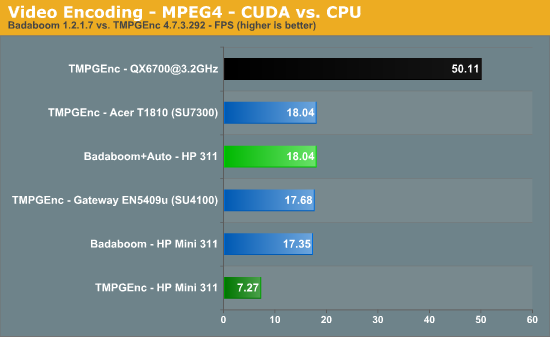HP Mini 311 — CUDA on ION
NVIDIA always likes to tout the advantages of their GPUs and CUDA. In theory, if you have a highly parallelizable task like video encoding/decoding/processing, you can accomplish that task a lot faster on a GPU than on a traditional CPU. When you add in the fact that Atom is already a very slow in-order architecture (albeit with Hyper-Threading), boosting performance of certain tasks could be very beneficial.
One of the applications NVIDIA talks about a lot with relation to CUDA is Badaboom. We haven't looked at in quite some time, and with the low performance of Atom CPUs it might be a viable option. We ran a test encode using Badaboom and a 720p source video, targeting the default "YouTube" output: 640x360 with 1000kbit VBR video and 128kbit MP3 audio. We also tweaked the Badaboom settings to enable auto key frame insertion for improved image quality and performance, which we'll see in a moment.
We can't run Badaboom on CPUs, unfortunately, so we used TMPGEnc 4.0 Xpress and similar settings: MPEG4 1000kbit video with 128kbit AAC audio. Interestingly, TMPGEnc also supports CUDA. However, the encoding is all done on the CPU, so the main benefit of CUDA for TMPGEnc is if you use some of the complex filters like noise reduction and smart sharpen. If you're just doing a straight video encode, CUDA doesn't appear to help TMPGEnc right now.
First up, here are the results, with CPU encoding time on an Acer Timeline 1810 as well as a desktop Core 2 Quad 3.2GHz thrown in for reference.

Badaboom ends up being about 2.5 times faster than doing the video encoding on the Atom N270. Hooray! It's also about the same speed as a Pentium SU4300, but an overclocked Kentsfield 3.2GHz CPU is still 2.8 times as fast. Can you do basic video encoding on the ION LE with Badaboom? Yes, but now let's discuss quality for a moment.
The highest quality encodes will always require multiple passes in order to provide a better analysis of how to best use the available file size. Badaboom doesn't support multiple passes, so we did a single-pass encode in TMPGEnc for comparison. File sizes are similar (4213KB TMPGEnc vs. 4205KB Badaboom). Below are the image captures of the encoded video.

Default Badaboom YouTube setting

Badaboom YouTube setting with Auto Key Frames

TMPGEnc 4.0 Express — Single pass MPEG4 AVC 1000kbit VBR (3000kbit max)
The initial encodes using the Badaboom YouTube defaults are, at times, horrific. The content of the source video (and the scene in particular) can make a big difference, but overall the default settings fail to produce optimal results. Fast motion content is the worst offender, but then doing a good compression of fast action content has always been a lot more difficult. Luckily, we determined that making one change — setting the Key Frame Mode to "Auto" instead of "Fixed" (with the default "Baseline" and not "Main" mode) — results in a much better image. We still give the quality lead to TMPGEnc — and if you do multiple passes, the gap widens — but as a compromise the CUDA-based Badaboom encoder can achieve some decent results. As for ION, it's not really fast enough to make CUDA compelling; a moderate CPU can easily produce better results. Move to a faster GPU (NVIDIA's GTX 260M does the same encode at around 82 FPS and GTX 280M is at 100 FPS) and CUDA can flex its muscles.
There are other concerns with Badaboom, however. We had quite a few sample videos that it wouldn't accept (including a standard MPEG2 video). We also had some issues with audio glitches — our test encoded video has a couple small gaps in the audio, and they're there every single time on multiple systems. It's a relatively easy to use tool, but ultimately it can provide encoding performance at the cost of flexibility and quality.
There are other CUDA applications, of course. We'll look at SimHD DVD up-sampling in our battery life tests for example. Another potentially useful tool is called vReveal, which can remove noise, improve contrast/lighting, and reduce shakiness in recorded videos. If you make videos with your cell phone or inexpensive digicam and you want to upload them to YouTube, vReveal might be worth a purchase. A better video recorder would be an even better purchase, of course.
Most of the CUDA tools at present focus on video (and to a lesser extent image) related activities, since these tend to be highly parallelizable. Anyone doing video editing/encoding work will want something far more powerful than an Atom-based netbook, even if it does have ION to help out. Ultimately, while CUDA is certainly interesting, we prefer a vendor-agnostic approach, and DirectCompute will hopefully provide that in the coming months (or years). We also need to maintain a balanced system — certain tasks still rely heavily on the CPU and aren't candidates for GPU acceleration — and Atom is nowhere near fast enough for a modern computer.










51 Comments
View All Comments
yyrkoon - Sunday, November 22, 2009 - link
I would have to agree.I picked up a Toshiba Satellite L305-S5921 for $399 free shipping. It only had 2 GB of RAM, and came with Vista home premium, so of course I purchased a 4GB kit at the same time ( both from the egg ).
I have not personally owned a netbook, but a friend of mine bought one for his wife, and I have to say it was dog slow. Boot times ranged around one minute, and the initial XP Home bootup was more like 3 minutes. I literally booted it up, walked away, did a few things, came back and it was still booting . . . Price at the time was slightly less than the notebook I purchased.
I have since retrograded to XP pro because the system was not directx 10 capable anyhow, and for me this would be the only reason to use Vista. Anyways, I do play games, and it will play games like GTA San Andreas maxed settings ( except 16 bit color ), at the native resolution, with no AA. It hardly ever stutters, usually only when I have background tasks running. What it will not do however, is play the most recent game titles well. I am fairly certain it would handle WoW just fine ( although I do not play it personally ).
As for non gaming tasks, it is hard to know you're using a laptop ( performance wise of course ). That is every day productive applications like Office 2007, or web browsing etc. It also has no problems playing movies, even HD content from YouTube. Used as a development machine, or the like, of course it would do things like compile applications slower. This is to be expected. Encoding movies would likely suffer as well.
Anyways, my point is; I can not see spending the same, or more money on a netbook , when you can purchase a laptop that will run circles around it. That is; Unless you think you're cool because you have an uber small PC. Or perhaps you have a legitimate reason such as being away from an electrical outlet for long periods of time. Or the power available to you is very minimal ( read: limited solar/wind power, or like the poster above who spends lots of time in the library researching and writing papers ).
yyrkoon - Sunday, November 22, 2009 - link
Sorry, I meant if this system were used to encode video, or compile application that it would be slower than most current desktops . . .fokka - Sunday, November 22, 2009 - link
no, i havent tried a timeline and -of course- the experience is better than the atom. the experience on my 2ghz c2d 2gb ddr2 5400rpm hdd dell should be even faster, at least in cpu-intensive apps, but the main advantage of the atom aint processing power, its a tdp of 2,5w and the low price, while delivering _enough_ power for most browsing, office and media-scenarios.i have nothing against ion, culv or c2d, im just saying atom is good enough, at least for a secondairy computer.
what we also have to consider is, that we, writing and reading a tech-site, are power users, we can overstress even the fastest desktops. average joe would a little bit less demanding, i think.
thanks for the answer, anyway ;)
JarredWalton - Sunday, November 22, 2009 - link
The thing is, CULV are 10W TDP and will typically use less than that, so if you can get that for the same price why not? Atom needs to be cheaper, like around the $300 mark, and in many cases it is. The HP Mini 311 isn't one of those designs, unfortunately. Also, even with Atom I'd like 2GB RAM, and the 2GB netbooks are all pushing into CULV pricing territory.fokka - Sunday, November 22, 2009 - link
so 10w are 4 times 2,5w and since both these numbers mean the tdp, i think atom lies beneath 2,5w most of the time.also, i spoke about atom in general, not in an ion netbook for 400$+, maybe i would get culv for that price, too.
i think we can settle this one down and resume that atom just aint powerful enough for _you_ ;) for me, my gf and millions of others it is.
in the end its about what you wanna do whith your machine and what you wanna pay for it.
and the 2gb you want to see in netbooks can easily be upgraded in most models
peace, it was a pleasure discussing with you :)
voltronn - Wednesday, November 25, 2009 - link
I recently got a little samsung NC10, and strangely, its taken over from my main powerhouse PC. Its just so handy, I can read the morning news while I eat breakfast at the table like a civilised human being. When I come home in the evening I just carry it down and plug it into a 22 inch monitor and watch tv/films. I press the ON button and within 7 or 8 seconds I can browse. Also, the battery life is key, because I don't have to keep the damn thing plugged in all the time.
Of course its fiddly and a little slow, but its just so handy, and it isn't some giant hulk or eyesore that takes up half my room.
If they can make them a little more powerful without upping the weight or loosing battery power then these little netbooks will be indespensible.
gaidin123 - Sunday, November 22, 2009 - link
I read this article on an Acer 1810T. It's a great notebook and the $400 1410 with the su2300 is an even better value. If you are in the market for a net/notebook you owe it to yourself to compare this line with whatever else you're looking at.One great surprise was that the thing supports simultaneous extended desktop on both the hdmi and vga ports (disabling the notebook screen) for multimonitor setups. The 1810T at least does 1080p x264 content using dxva in mpc-hc just fine.
ET - Sunday, November 22, 2009 - link
The comparison to the 1810 Timeline is a good one, and I'd love to see a review comparing performance of that notebook. Looks like we're at a point where netbooks have grown big enough and notebooks have grown small light and inexpensive enough that the distinction is blurring. Which I think is how things should be. Making a point to benchmark netbooks/notebooks of similar dimensions together might help sort out this market.ET - Sunday, November 22, 2009 - link
Hopefully you'll have an ASUS Eee PC 1201N for review. The dual core Atom might make a difference when it comes to gaming.For games, I think that it'd be nice of you could try out WoW. Playing MMO's is an obvious "net" activity. When I was playing City of Heroes, I used to want to play it while on the road, on my Fujitsu P1510D. Horrible experience, I can tell you, although it at least worked.
StevoLincolnite - Sunday, November 22, 2009 - link
Might I add that it is possible to enable Direct X 10 on the ION LE? Just by forcing the drivers to think it's a regular ION will make that happen, it also comes with a small performance boost.Might be worth checking out.